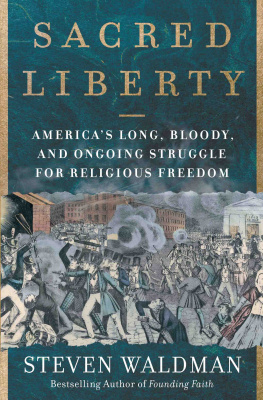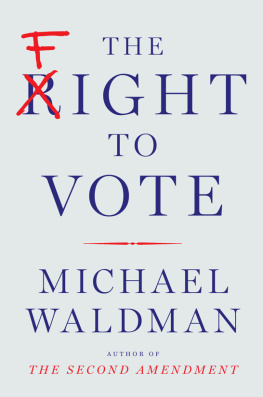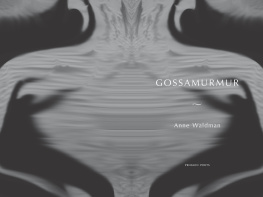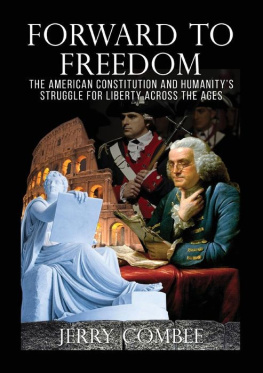T he Reverend John Waller was preaching in Caroline County, Virginia, in 1771 when an Anglican minister strode up to the pulpit and jammed the butt end of a horse whip into his mouth. Waller was dragged outside, where a local sheriff beat him bloody.
These were among 150 major attacks against Baptists in Virginia between 1760 and 1778, many of them carried out by leaders of local Anglican churchesand, significantly, many of them within a horse ride of a young James Madison.
This vexes me the most of any thing, Madison, then twenty-three, complained to his friend William Bradford in 1774. He told Bradford that five or six well-meaning Baptist ministers were at that moment imprisoned in neighboring Culpeper County for what he considered an absurd chargepreaching the gospel and publishing their religious Sentiments. In the two years since Madison returned home from college in New Jersey, he had squabbled and scolded about the abuse of the Baptists but to little avail: That diabolical, Hell-conceived principle of persecution rages.
As alien as these kinds of attacks seem todayAnglican ministers brutalizing Baptist ministers on the eve of the American Revolution?they were much more common in our history than we like to admit. Those who demand religious rights have too often been mocked and murdered, tarred and feathered. The same nation that boasts of its commitment to religious liberty also allowed for the following injustices.
- In the seventeenth century, Massachusetts hanged people for being Quakers.
- When the Declaration of Independence was signed, nine of the thirteen colonies barred Catholics and Jews from holding office.
- In 1838, the governor of Missouri issued Executive Order 44, calling for the extermination of the Mormons.
- Protestant mobs burned convents, sacked churches, and collected the teeth of deceased nuns as souvenirs during anti-Catholic riots in the 1830sjust one of the many spasms of anti-papism that roiled America from the colonial era until well into the twentieth century.
- Hundreds of thousands of Africans were stripped of not only their liberty but also their religions when they were brought to America, in what one historian called a spiritual holocaust.
- After the Civil War, the United States government banned many Native American spiritual practices while coercing indigenous children to convert to Christianity.
- Before and during World War II, Jehovahs Witnesses were imprisoned, beaten, and even castrated for refusing, as a matter of conscience, to salute the American flag.
Yet today we enjoy such robust religious freedom that this litany of persecutions is horrifying. Proof of how far we have come was on display in 2016 when the United States Supreme Court began its session by seating six Catholics and three Jews as justices. Men and women who would not have been allowed to hold office in early America would pass judgment on paramount questions of state, including religious liberty. Progress can also be seen each time Congress convenes, with invocations offered by every flavor of Christian clergy as well as by Muslim imams, Hindu priests, and Jewish rabbis.
Or consider the story of Parley Pratt, one of the original twelve apostles who helped found the Church of Jesus Christ of Latter-day Saints. Pratt was imprisoned in 1838 with Mormonisms founder, Joseph Smith, and driven out of Missouri by mobs of angry Protestants. Pratt had twelve wives and was later murdered by the estranged former husband of one of them.
More recently we saw a grassroots demonstration of the American love of religious freedom when thousands of people of different faiths flooded airports in 2017 to protest President Donald Trumps plan to ban Muslim immigrants. After Trump floated the idea of creating a national registry of Muslims, Jonathan Greenblatt, chief executive officer of the Anti-Defamation League, the leading group fighting anti-Semitism in the United States, offered a poetically effective response: Because I am committed to the fight against anti-Semitism... if one day Muslim-Americans are forced to register their identities, that is the day this proud Jew will register as Muslim.
The strength of Americas approach may be judged not just in the relative absence of persecution but in the nations spiritual vibrancythree hundred sixty thousand houses of worship, from Adventist to Zoroastrian, from urban storefront churches that seat a dozen to Christian mega-churches that hold forty thousand. America has reduced religious persecution without subduing religious passion.
This accomplishment is rare in world history. For millennia, societies have puzzled over how to have both religion and freedom. Government efforts to promote a single faith often had short-term benefitsthe favored religion would gain influence, wealth, and securitybut they levied tragic costs as well: wars against heretics, persecution of religious minorities, and corruption of the faith itself. Thomas Jefferson complained that the quest for doctrinal orthodoxy had made of Christendom a slaughter house, and at this day divides it into Casts of inextinguishable hatred to one another. Rather, the troubles arise because majority groups have invariably expected their faith to dominate, usually at the expense of religious minorities.
Today, most nations still have not found the right balance. More than three-quarters of the worlds population lives in countries with limited religious freedom.
The more successful American paradigm has emerged over many years, shaped through civil disobedience, elections, lawsuits, coalition building, and bloodshed. Won through great struggle, religious freedom achieved an exalted status as a core element of our national identity. In allowing Americans to follow their souls yearnings, religious freedom has become a sacred liberty. While this book describes Americas little-known history of religious persecution, it is ultimately about how the nation moved forward. It is no exaggeration to say that Americas unique approach to religious freedom is one of its greatest inventions.
* * *
Ratification of the First Amendment to the United States ConstitutionCongress shall make no law respecting the establishment of religion, or prohibiting the free exercise thereofwas, of course, extremely important. But that did not by itself produce full religious liberty, any more than the Declaration of Independence gave African Americans civil rights. The struggle to make religious freedom real in America has been long and tempestuous.
As with civil rights, the journey began with a set of ideas. The most significant visionaryand the most effective activist for religious freedomwas Madison, who wrote the seminal treatise Memorial and Remonstrance Against Religious Assessments and engineered the passage of the Virginia Statute for Religious Freedom before then guiding the creation of both the Constitution and its First Amendment. More than anyone else, this underappreciated founder devised the ingenious, counterintuitive, and often-misunderstood blueprint for the religious liberty we enjoy today.
First, he argued that the best way to promote religion was to leave it alone. This was revolutionary. In all of previous human history, those who wanted to encourage religion had enlisted the governments help. Madison believed that the state should neither constrain nor coddle religion and, above all, that it should not favor one faith over another. Even well-intentioned efforts would backfire, he insisted, sapping religion of its strength. His thinking was highly influenced by his interactions with Virginias much-persecuted Baptists, the first of many times when evangelical Christians would play a central role in advancing religious liberty. Like the evangelicals, Madison ardently supported the separation of church and statenot because he wanted to secularize society but, to the contrary, because he believed that it was the only way to ensure that religion would flourish.











